Creative Bookshelf Ideas to Transform Your Space
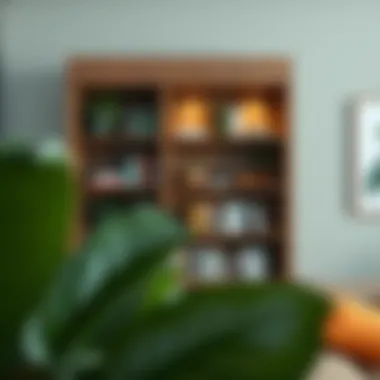
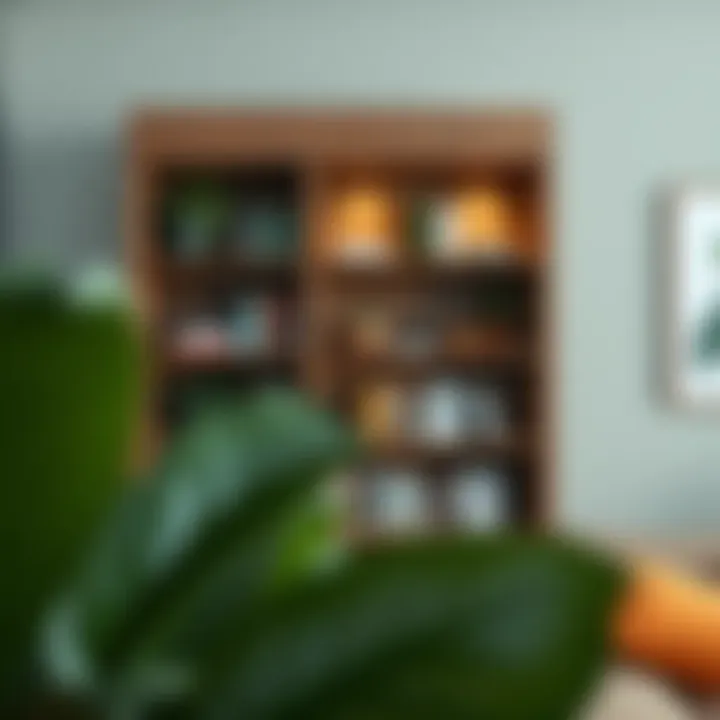
Intro
Bookshelves often represent more than just storage; they embody personality, design allure, and functionality within a given space. Whether nestled in a cozy corner of a living room, acting as a statement piece in an office, or gracing a hall with character, these structures can seamlessly blend utility with artistic expression. Therefore, understanding innovative bookshelf ideas becomes paramount for anyone looking to elevate their environments.
Design Inspirations
In this section, we delve into several creative inspirations that intertwine style with practicality, allowing you to not just store books but also enhance your space's aesthetic appeal.
Trending Styles
The world of bookshelf design is ever-changing, often reflecting broader trends in interior design. Think back to minimalist designs that emphasize clean lines and spaciousness. These styles can be particularly effective in smaller rooms; they provide an uncluttered look that allows other decor elements to shine without overwhelming them.
On the contrary, vintage styles have made a grand comeback. Imagine a reclaimed wood shelf showcasing not only books but cherished mementos. To create a eclectic fusion, consider mixing materials across your shelving. For instance, pairing metal supports with wooden planks gives a robust feel, suitable for a modern industrial vibe.
Tip: Integrating indoor plants into your bookshelf design not only livens up the space but improves air quality, creating a nurturing atmosphere for both books and dwellers alike.
Color Palettes
Color choice plays a significant role in setting tones and moods within spaces. For a serene ambiance, lighter hues such as soft greys or whites can create a calming environment, making reading more pleasurable. Alternatively, bold colors—such as deep navy blue or forest green—can energize a room and serve as focal points.
Moreover, gradient techniques are an eye-catching trend. Imagine books arranged in such a way that their spines transition from dark to light, enhancing visual appeal while maintaining order.
"The right colors can either soothe or invigorate, creating a personalized atmosphere that resonates with your style."
Combining a fashionable color strategy with well-thought out positioning—shelves at varied heights or angles—can lead to stunning visual effects and optimize available space.
Understanding the Role of Bookshelves in Interior Design
Bookshelves are not just practical storage solutions; they serve a vital function in shaping the overall aesthetic and ambiance of any room. They can reflect personal styles, organize clutter, and even convey a sense of sophistication or casual comfort, depending on their design and placement. Recent trends emphasize the role of bookshelves as integral parts of both home and office decor, merging utility with strong visual elements.
Why Bookshelves Matter
- Visual Focal Points: A well-designed bookshelf can act as a statement piece, drawing the eye and enhancing the design narrative of a room.
- Organization: They provide a structured way to organize not only books but also various decorative items.
- Space Utilization: In small spaces especially, bookshelves can maximize vertical space, allowing users to create more functional living areas.
The discussion of bookshelves converges around essential questions: What design elements make a bookshelf stand out? How do they complement the rest of the room's decor? Considering these factors will ensure that your bookshelf becomes a valuable asset rather than just a piece of furniture.
Historical Perspective on Bookshelf Design
Bookshelf design has evolved considerably over time. Initially, these structures were mere shelves to hold manuscripts in monasteries. The first modern bookshelves began to emerge during the Renaissance period, where ornate woodwork and intricate details were not uncommon. Fast forward to the Industrial Revolution, when mass production changed the game. Now, you could find practical bookshelves in homes and public libraries alike, paving the way for greater accessibility of information.
In the 20th century, the rise of minimalism shifted the focus towards functionality and clean lines. One might say that bookshelves began to tell stories not just through the literature they housed but through their own design journey.
Modern Trends in Bookshelf Aesthetics
These days, bookshelves come in an array of styles, from sleek minimalist designs to bohemian statement pieces. It’s fascinating how the integration of technology plays a role too. Smart shelving systems are gaining popularity, allowing users to adjust shelving heights seamlessly or integrate lighting effects with just a flick of a switch.
Key Trends to Consider:
- Open Shelving: This invites people to interact with your books and decorations while keeping a light feeling in the room.
- Custom Designs: With advancements in materials and technology, custom-made shelves are gaining traction for those wanting a precise fit and unique aesthetic.
- Versatile Functions: Beyond merely housing books, modern shelves are designed to hold plants, art, and even tech, blending sectors of decor in an innovative way.
"Bookshelves can be the heartbeat of a room, resonating with stories yet to be discovered."
The contemporary bookshelf is a canvas waiting for personality and creativity to shine. Whether for a cozy nook at home or a chic office space, the right bookshelf elevates the atmosphere, making it both functional and intriguing.
Selecting the Right Bookshelf for Your Space
Choosing the perfect bookshelf is more than just picking any old piece of wood with some squares carved into it. It's about making a statement, creating a focal point, and ensuring your collection of literary treasures doesn’t just sit in a stack collecting dust. Our surroundings influence our mood and productivity, and a well-selected bookshelf can enhance both aesthetics and functionality drastically.
When thinking about selecting a bookshelf, it's essential to consider the overall theme of your space. Does it echo a rustic charm, or does it lean towards sleek modernism? Bookshelves, after all, can serve various purposes—be it purely for storage, decorative accents, or as part of a room’s layout. You want a bookshelf that harmonizes with your environment, rather than competing for attention with it.
Moreover, size and scale play significant roles here. An oversized bookshelf in a cozy nook might feel overwhelming, while a tiny one in a spacious living room could vanish without a trace. Thus, honing in on these specifics is paramount to the overall success of your selection.
Considerations for Size and Scale
When shopping for a bookshelf, first things first—measure your space, or you might end up with a towering monstrosity that shadows the entire room. There’s a fine line between showcasing your collection and cluttering the ambience.
A quick and dirty rule? The bookshelf should complement—you shouldn’t feel it’s overpowering or squeezing the life out of your living space. Here are some aspects to consider:
- Height: Think about where you want to place your bookshelf. A towering piece can draw the eye upward, adding an illusion of height to shorter spaces. On the other hand, if you're working with a sloped ceiling, a lower bookshelf might be more practical.
- Width: An overly wide shelf can consume precious space in smaller rooms. So, narrow profiles that utilize vertical space effectively might be your best bet.
- Depth: Bookshelves needn’t be deep. If you’re merely displaying books (not hiding them away), shallower shelves could work wonders, leaving room for decorative trinkets or lamps.
"Size does matter! Opt for pieces that reflect your space rather than dominate it."
Choosing Materials and Finishes
Materials and finishes are where your bookshelf can really show off. Selecting the right material significantly impacts durability, style, and overall feel. Take wood: classic, timeless, heavy on texture, and can be dressed up or down depending on your decor. But there’s a world of other options out there too.
- Metal: A sleek, industrial approach can provide an edgy look. Metal frames can be incredibly sturdy, making them excellent for holding hefty tomes and art pieces alike.
- Glass: Looking for a modern flair? Glass shelves mounted on minimalistic frames give an airy feeling to the room. They can create the illusion of space if the area feels cramped.
- Composite Wood: For those on a tighter budget, composite materials offer a great alternative without sacrificing style. They can mimic the look of wood at a fraction of the cost, making them fit for those vintage or contemporary themes.
- Finishes: Here’s where you can get playful. A matte finish can provide a modern feel while a glossy lacquer might give it a retro vibe. Different stains can enhance the wood textures, creating accents and shadows that catch the eye.
In summary, selecting the right bookshelf isn’t just about storage; it's about expressing your personal aesthetic and how well it cooperates with the entire space. Applying careful consideration to size and materials will lead to a serene environment while effectively showcasing your cherished books.
Creative Arrangements for Books
In the realm of interior design, the arrangements of books can be the difference between a crowded bookshelf and a masterpiece of creativity and function. When books are thoughtfully arranged, they don't just serve their literary purpose—they contribute to the overall aesthetic of the space. Displaying your books should be as much about showcasing your personality as it is about functionality. By experimenting with how books are arranged, you can derive both visual satisfaction and practical benefits. Here are three engaging ways to consider arranging your books that can invigorate your environment and reflect your unique taste.
Alternating Horizontal and Vertical Stacking
One of the most engaging methods of displaying books is by alternating vertical and horizontal stacking. This technique plays with the viewer's eye, creating a rhythm that makes the bookshelf visually intriguing.
By vertically stacking some books and laying others down, you create various levels and focal points. This method allows for easy access to favorite reads while simultaneously giving you the opportunity to showcase cover designs that you adore. Consider using the horizontal books as a base for small plants or decorative items, which not only enhances the aesthetic but also adds a layer of interest.
Another benefit? It breaks up the monotony of a uniform bookshelf and encourages juxtaposition, which can lead to conversations. If you are looking to elevate your presentations during parties or small gatherings, this method might just be your golden ticket.
"Art isn't just about what you display; it's about how you display it."
Using Color for Impactful Displays
Colors hold the power to transform a shelf from drab to fab in seconds. When organizing your books, consider grouping them by color to create a striking impact. This technique attracts attention instantly and becomes a visual focal point in any room. You might split the arrangement into gradients, rainbow hues, or even by color themes—think shades of blue for a calm vibe or vibrant reds for energy.
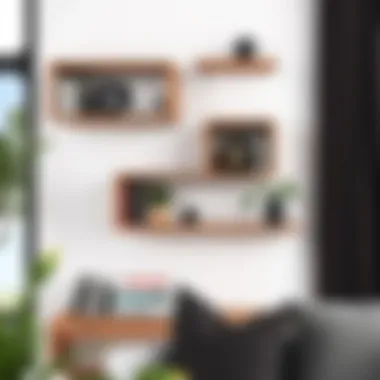
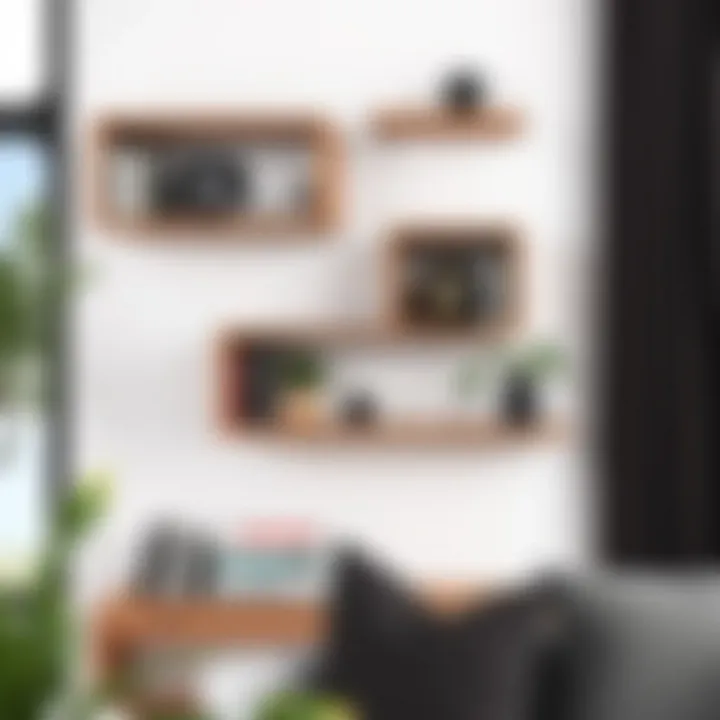
In-room designs where color plays a significant role, using your books as part of that dialogue can be exciting. If a room already has a theme, like nautical or bohemian, you can easily find ways to enhance it with color-coordinated books. Another approach is to mix in decorative bookends that also reflect the colors or themes you are pursuing. This interplay not only breathes life into your bookshelf but can completely brighten up the look of the room.
Incorporating Decorative Objects
Your bookshelf doesn’t have to play host only to books; it can also be a stage for decorative objects that speak to your interests or aesthetic preferences. By integrating decorative pieces—such as sculptures, framed photos, or unique finds—between books can give them a sense of individuality and increase textural diversity.
Curating these items allows you to tell a story with your bookshelf, as every piece can spark curiosity and intrigue. Imagine a vintage record player nestled between classic novels, or a beautiful clock amongst art books. It not only spices things up visually but can also entertain and engage guests when they skim through your collection. Best of all, these objects can serve as a natural way to introduce personal memories, bringing a unique flavor to your decor.
Transforming Your Bookshelf into a Functional Space
In a world where every square inch of space counts, the bookshelf has evolved from a mere book-holding structure into a multifaceted piece of furniture with endless possibilities. Focusing on transforming your bookshelf into a functional space isn’t just about aesthetics; it’s about maximizing utility in our living and working environments. A well-designed bookshelf can serve as a storage solution, a decorative element, and even a space to showcase your unique personality. The importance of this transformation lies in the balance between style and practicality.
Multi-Purpose Shelving Ideas
When considering how to make the most of your bookshelf, embracing a multi-purpose design is crucial. This approach not only frees up space but adds versatility.
- Combining storage solutions: Consider integrating boxes or baskets into the shelves. They can hold non-book items, such as games, office supplies, or craft materials, while maintaining a neat appearance.
- Incorporating a desk or workspace: For those tight on space, attach a small desk to the side or bottom of the bookshelf. This allows an effortless transition from reading to work without even standing up.
- Floating shelves: A great option for smaller areas, floating shelves can host books on top while providing a surface underneath for plants or art. This just adds layers to the room without taking up physical floor space.
"A bookshelf is more than just wood and books; it’s a statement of style and utility, woven seamlessly into the fabric of room design."
Incorporating Lighting for Enhanced Visibility
Another facet of transforming your bookshelf is the integration of lighting. Proper illumination can highlight the contents of the shelf, create ambiance, and improve the overall functionality of the space. Here’s how to incorporate lighting effectively:
- LED strip lights: These are an easy and popular choice. Placing LED strips along the shelves provides an ethereal glow, enhancing the visual appeal of books and objects, especially in the evening hours. They are also energy-efficient, lasting for years.
- Spotlights or wall sconces: Focused lighting on specific areas can draw attention to your favorite titles or unique decorative elements. Consider installing these at strategic angles to add depth and highlight textures.
- Lighted display cases: If you have valuable items, consider a display case within your bookshelf setup. Built-in lighting can protect these items from dust and fading while showcasing them at their best.
Incorporating Nature with Bookshelves
In today’s interior design landscape, bringing elements of nature indoors is a growing trend. More than just a design flair, incorporating nature with bookshelves offers numerous benefits, from enhancing aesthetics to improving well-being. Bookshelves can serve as more than just storage; they can transform into vibrant displays of life and greenery, creating a harmonious balance between the literary world and nature. Let’s explore how we can turn traditional shelving into lush, living spaces.
Bookshelves as Planters
Creating a bookshelf that doubles as a planter isn't merely an innovative idea; it’s a bold statement. Imagine a shelf where books intermingle with plants, offering an aesthetic that’s both refreshing and serene.
- Types of Plants: Choose succulents or air plants for low-maintenance greenery. They require less watering and can thrive in unique environments, making them ideal for busy lifestyles.
- Planter Integration: Consider incorporating small pots or built-in planters. This allows you to give books their space while also providing a home for your green friends. Attach vertical planters on the sides of the bookshelf or use floating shelves to display your mini-garden.
- Benefits of Biophilic Design: Not only does this arrangement add visual interest, but it also works wonders for air quality. Studies show that plants can reduce stress, boost creativity, and enhance focus—making this setup not just beautiful, but beneficial.
“Plants can increase productivity and creativity while reducing stress levels. Integrating them into your bookshelf makes for a holistic environment.”
Using Natural Wood Finishes
When selecting finishes for your bookshelf, consider the beauty and warmth of natural wood. Using wood with a rich grain adds character and creates a warm, inviting space, effectively fusing the raw aesthetic of nature with functional design.
- Sustainable Choices: Opt for reclaimed wood or sustainably sourced timber. This not only reduces environmental impact but also tells a unique story with each piece.
- Finishing Techniques: Emphasize the natural grain by using simple oil finishes or matte varnishes. They enhance the wood’s texture without overwhelming it, preserving the organic look and feel.
- Color Palette: Natural wood can harmonize with various decor styles. Whether you're aiming for a rustic charm or a modern minimalist vibe, natural wood finishes can seamlessly fit into your aesthetic vision.
Incorporating nature into your bookshelf can transform it from just a storage space into a dynamic focal point of your home. By considering bookshelves as planters or utilizing natural wood finishes, you create a multifaceted design that celebrates both literature and life.
Maximizing Small Spaces with Bookshelves
In today's world, where urban living often means compromising on space, the role of bookshelves transcends beyond mere storage. They evolve into strategic players in interior design, turning quirky corners and overlooked nooks into functional and stylish havens. Properly managed, a bookshelf can transform a cramped studio or a humble reading nook into an artful display, making even the tiniest of spaces feel coherent and welcoming.
Benefits of Maximizing Small Spaces with Bookshelves
- Utilization of Vertical Space: When square footage is limited, think vertically. Wall space is often underutilized. By extending your bookshelf upwards, you can effectively combat the issue of floor plan claustrophobia.
- Multi-Functionality: Each shelf can serve a dual purpose—housing both books and aesthetically pleasing décor, or even practical items like small plants.
- Visual Appeal: An organized bookshelf can act as an eye-catching element, breaking the monotony of blank walls and livening up the interior.
- Customized Solutions: Consider tailored shelving that fits snugly into unusual spaces, reflecting personal tastes while being snugly functional.
Choosing to maximize the utility of small spaces with bookshelves is not merely a trend; it's a necessity for efficient living. We explore two significant solutions—wall-mounted options and corner shelving techniques—to breathe life into small environments.
Wall-Mounted Solutions
Wall-mounted bookshelves are a clever way to make a small area feel larger and less cluttered. They free up floor space while drawing the eye upwards, creating an illusion of height. These shelves come in various designs, from floating units that allow an airy look to wooden, industrial styles for a more rugged vibe.
When considering wall-mounted solutions, some factors should be kept in mind:
- Installation: Ensure that the shelves are securely fitted. Finding studs in the wall is essential. A half-hearted installation can be disastrous when heavy books are involved!
- Design Compatibility: Choose a design that complements your existing decor. Whether you’re going for a minimalist Scandinavian look or an eclectic bohemian style, your shelves should enhance—not clash with—your surroundings.
- Accessibility: Install shelves at reachable heights. You want those favorite reads to be easily grabbed, not gathering dust atop a high shelf!
Often, some individuals opt for open shelves, but it's wise to consider incorporating ledges or even small cabinets with glass doors to keep the dust bunnies at bay.
Corner Shelving Techniques
Corners are often the forgotten zones of any room, but with a little creativity, they can serve as standout features. Corner shelving utilizes what would generally be wasted space, turning it into a functional, stylish showcase. Whether you invest in a pre-made corner unit or go the DIY route, these shelves can be truly transformative.
Some noteworthy techniques include:
- Ladder Shelves: These lean against the wall and fan out, perfect for holding books on each step while still claiming that corner space stylishly.
- Custom Built-ins: If you’re feeling ambitious, custom shelving fits seamlessly in a corner, making a bold statement without encroaching upon your living space. This can even lead to some cozy nooks for reading or a serene growth of indoor plants while showcasing your favorite books and items.
"Transform your ordinary corners into extraordinary focal points—because every inch counts!"
In summary, maximizing small spaces with bookshelves involves strategic planning, smart designs, and a dash of originality. Wall-mounted options and corner techniques allow for elegant solutions, turning even the smallest of areas into something not only functional but a reflection of personal style.
Customizing Bookshelves to Reflect Personality
When it comes to interior design, a bookshelf isn't merely a practical storage solution. Rather, it's a canvas where one can project their tastes, interests, and experiences. Customizing bookshelves to reflect one's personality gives life and character to a space, transforming a simple piece of furniture into a unique statement. This personalization can significantly enhance the aesthetic appeal of a home or office, making it more inviting and expressive.
Benefits of customizing your bookshelf are manifold: it allows for creativity, encourages personal expression, and can set the mood of a room. Each item on display tells a story — from cherished books to beloved mementos. Moreover, considering your personality traits, hobbies, and preferences while designing a bookshelf can lead to a more harmonious living space.
However, it’s also important to consider factors such as the overall home decor, functionality, and cohesiveness with the rest of your furniture. Ask yourself: What do I want my bookshelves to say about me? What colors do I find soothing or stimulating? How can I make this shelf not only a storage space but also a conversation starter?
Personalized Color Schemes
Color is a significant element in interior design, and it plays a crucial role in customizing bookshelves. Personalizing color schemes can evoke emotions and create distinctive atmospheres in any room. Choosing a color palette that resonates with one’s personality is an essential step in this process.
Here are some considerations for selecting colors for your bookshelves:
- Mood Setting: Choose colors that reflect your mood or desired ambiance. Soft blues and greens can create tranquility, while bold reds and oranges might energize a space.
- Contrast and Harmony: Consider how the colors will contrast with or complement your existing decor. A bold color might stand out beautifully against neutral walls, while a more subtle tone might blend seamlessly.
- Variety vs. Uniformity: Decide whether you wish to mix various colors for a vibrant look or go for a monochromatic scheme for a sleek, structured feel.
A creative approach could be painting the bookshelf itself in a color that stands out, or alternatively, using colorful book covers and decorative items to make an eye-catching impact.
Incorporating Unique Artwork
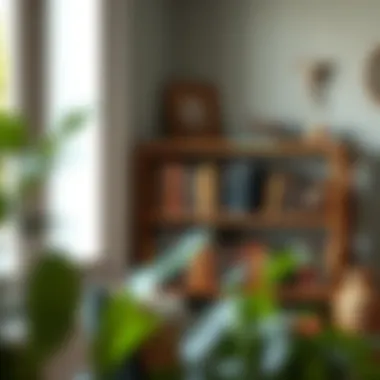
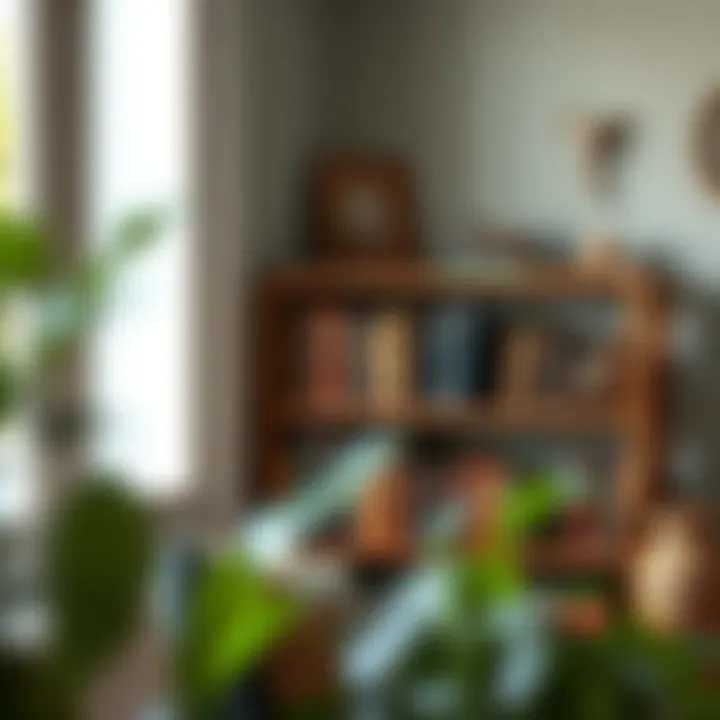
To further personalize a bookshelf, integrating unique artwork offers an opportunity to enrich the design and express individual taste. Artwork can range from framed prints and photographs to handmade crafts or specialty sculptures.
Here are some ways to effectively incorporate artwork:
- Layering Techniques: Arrange artwork behind or above shelf contents, allowing for layers of interest. This can make a dramatic focal point, enhancing visual depth.
- Thematic Consistency: Select artwork that aligns with your books or the overarching theme of your space. For instance, coastal artwork can harmonize beautifully with seaside novels.
- Personal Touches: Display personal pieces such as family photographs or travel souvenirs that speak volumes about your experiences and voyages.
- Rotation of Display Items: Change artworks periodically to keep the aesthetic fresh and reflect your evolving tastes over time.
"Your bookshelf is a representation of you — the journeys you’ve taken, the stories that have shaped you, and the dreams that inspire your future."
If you'd like more inspiration for personalizing your space, consider visiting Britannica or forums like Reddit for a multitude of ideas and discussions.
Functional Decor: Organizing Beyond Books
When you think of a bookshelf, the first thing that springs to mind is often a collection of books neatly arranged on sturdy shelves. However, the potential of a bookshelf extends far beyond literary treasures. Integrating functional decor into your bookshelf setup can turn it into a versatile space that showcases flair while serving practical purposes. This concept plays a pivotal role in enhancing both the aesthetic and functional appeal of any room, making it an invaluable aspect of interior design.
Utilizing bookshelves for organizing items beyond just books offers multiple benefits. For one, it helps in decluttering spaces, enabling you to create an organized yet stylish environment. Moreover, incorporating decor elements such as office supplies or personal collections can reflect your personality, making the bookshelf a personalized statement piece in your home or workspace. Here are a couple of specific strategies to consider:
Integrating Office Supplies
Bookshelves aren't just havens for novels and works of fiction; they can also be effective holding areas for office supplies. Instead of stuffing away pens, notepads, and other essentials in drawers that you seldom open, why not put them on display?
By using aesthetically pleasing organizers, such as wicker baskets or sleek metal containers, you can keep your supplies at your fingertips while ensuring everything looks tidy.
To set this up, consider the following tips:
- Select Stylish Organizers: Employ organizers that complement the bookshelf's design, such as clear acrylic bins or elegant wood caddies.
- Designate Specific Spaces: Allocate particular sections of your bookshelves solely for office tools. This not only creates order but also adds a layer of functionality.
- Incorporate Branding: You can include branded office materials or elegant stationery that mirrors your taste. They will not just serve a purpose but also enhance the overall look of the bookshelf.
"An organized workspace promotes not only productivity but also encourages creativity and inspiration."
Showcasing Personal Collections
Almost everyone has a hobby or collection they're proud of, whether it be vintage cameras, globes, or even miniature art pieces. Leveraging your bookshelf to showcase these collections can transform an ordinary shelf into a stunning visual display. Not only does it enhance the ambiance of the room, but it also invites conversation, making it a focal point for guests.
Here's how you can achieve this look:
- Curate Thoughtfully: Instead of randomly placing items, curate your collection and arrange them in an interesting way. Consider height variations and clustering similar items together to create visual depth.
- Mix and Match: Combine your collections with a few select books or personal memorabilia to tell a story. Family photographs or travel mementos can add a personal touch that resonates.
- Consider Lighting: If the bookshelf is in a dimly lit area, you can think about adding small LED spotlights or decorative fairy lights to highlight your collection beautifully.
Integrating these functional elements into your bookshelf is a surefire way to elevate its utility while maintaining a high aesthetic standard. Not only does it lead to better organization, but it also personalizes your space, making sure that your bookshelf represents who you are.
Sustainable Ideas for Bookshelves
Sustainability has become more than just a buzzword; it's a lifestyle choice that resonates deeply across various domains, including interior design. When it comes to bookshelves, implementing sustainable ideas not only addresses environmental concerns but adds unique character to your space. Making eco-friendly choices can lead to creative, one-of-a-kind solutions that reflect your values while beautifying your home or office. Here, we’ll dive into two compelling methods for achieving sustainability: repurposing old furniture and using recycled materials.
Repurposing Old Furniture
Repurposing old furniture is like giving a second life to items that might otherwise end up in a landfill. It's a way to foster creativity and uniqueness in your living space. Think of the possibilities: an old dresser can be transformed into a charming bookshelf, complete with original drawers that can hold knick-knacks or garden tools.
What makes this approach particularly enriching is that every piece tells a story; it brings with it a history, which can be a beautiful conversational starter. Here are a few points to consider when undertaking this eco-friendly project:
- Personal Touch: Customize your repurposed bookshelf to mirror your personal style. A simple coat of paint, new hardware, or a modish finish can breathe new life into old furniture.
- Functionality: Not all old furniture is immediately suitable for a bookshelf. However, items with sturdy construction, like vintage cabinets, could work perfectly when arranged thoughtfully.
- Preservation: Keep in mind that older pieces may need some repair work. Investing time into restoration enhances not only the look but also the lifespan of the piece.
"Repurposing isn’t just about saving the environment—it’s about sparking joy in your space."
Using Recycled Materials
Using recycled materials to create bookshelves is another splendid way to foster sustainability. This practice not only reduces the demand for new raw resources but also champions the creativity of crafting something fresh from what’s available. Recycled materials can range from reclaimed wood to repurposed metal frames, and they can dramatically impact the aesthetic of your space.
Here are insights into how to utilize recycled materials effectively:
- Local Sourcing: Check with local salvage yards or community groups that specialize in reclaimed materials. You may stumble upon hidden gems that inspire unique designs.
- Diverse Materials: Consider mixing materials for a more eclectic look—like combining reclaimed wood with metal shelving brackets, which can create striking contrasts in texture.
- DIY Projects: Engage in DIY projects where you can blend functionality with art. For instance, old wooden pallets can be crafted into rustic bookshelves, adding an earthy ambiance to your space.
By implementing these sustainable bookshelf ideas, not only do you care for the environment, but you also cultivate a living space that showcases creativity and personal touch. Ultimately, every bookshelf becomes an expression of who you are and what you value.
The Impact of Technology on Bookshelves
In today’s fast-paced world, the integration of technology into every aspect of our lives has become increasingly essential. Bookshelves, often viewed through a purely aesthetic lens, are evolving far beyond mere storage solutions. Their role in interior design and functionality is being redefined by smart technologies and digital manifestations. This article examines these changes, shedding light on how technology can not only enhance the utility of bookshelves but also contribute to their visual appeal.
Smart Shelving Systems
Smart shelving systems represent the forefront of innovation in bookshelf design. These are not your grandmother's bookcases; they come equipped with features that cater to modern needs and smart home environments. Imagine a bookshelf that not only holds your beloved tomes but also serves as a digital assistant. Smart shelves can come with built-in sensors that trigger lighting to illuminate whatever you need, be it a favorite novel or a decorative item, all controlled by your smartphone.
A popular model, for instance, is the Lynk Smart Shelf, which can manage your reading habits, sync with your smart devices, and even remind you when it’s time to return a library book. This kind of technology opens up possibilities not just for efficiency but for creating a personalized experience in your home. Why deal with chaotic clutter, when you can have a shelf that organizes and manages for you?
"In a world where data is everything, having a smart bookshelf can make your literary collection not just visible but accessible."
When considering smart shelving options, it’s vital to factor in connectivity. Compatibility with existing smart home systems—such as those from Philips Hue or Amazon Echo—can significantly elevate your experience. Enhancing user-friendliness, smart shelves can also include adjustable mounts, allowing readers to easily change the height or angle of their books at will.
Displaying Digital Collections
The era of physical books is not over, but the surge of digital media has changed how collections can be displayed. Bookshelves are now transforming into sleek showcases for e-readers and tablets. Instead of cramming your physical space with stacks of manuals or digitized pages, a well-designed multimedia bookshelf can serve as a central hub for both literature and technology.
One idea is to dedicate a section of your bookshelf to display e-readers elegantly. Custom-built slots that accommodate devices like Kobo Clara or Amazon Kindle Oasis not only keep them safe but also emphasize their utility as modern reading devices. It's a fantastic way to merge the old with the new, reminding us that, while technology advances, the love for reading remains constant.
Additionally, you can integrate digital frames to showcase your digital collections, including photographs, artworks, or even cover designs of your favorite e-books. Crafting a digital gallery right on your bookshelf provides not just function but also an interactive visual experience. Imagine coming home to a bookshelf that tells a story, one that combines the physical and the digital realms.
By aligning technology with bookshelf design, homeowners and interior designers can create spaces that reflect individual style while being functional. Embracing this tech-savvy approach might be just what your space needs to evolve into something fresh and inviting.
Bookshelf Maintenance and Care
Maintaining and caring for your bookshelf isn't just about keeping it looking good; it's about preserving the integrity of your books and decor. A well-maintained bookshelf can serve as a stylish cornerstone of your design, offering functionality and charm. The sheer variety of materials involved in bookshelf design—from wood to metal and glass—calls for understanding the special needs of each to prevent deterioration and keep everything in tip-top shape.
Cleaning Techniques for Various Materials
When it comes to cleaning your bookshelves, the materials play a pivotal role. Each type requires a tailored approach for optimal care:
- Wood: A soft, dry cloth is your best friend. Avoid using too much water, as it can warp the wood. For deeper cleaning, a mix of mild soap and water can be used—just remember to dry it immediately afterward. If your bookshelf has a finish, be cautious with cleaners; they can strip the finish away.
- Metal: For metal shelves, a damp cloth combined with a non-abrasive cleaner will suffice. If rust forms, a mixture of vinegar and baking soda can help scrub it away without scratching the surface.
- Glass: Glass shelves demand extra finesse. Use a glass cleaner or a mix of vinegar and water. Microfiber cloths are excellent for avoiding streaks. Be careful when cleaning corners; they can be tricky.
Keep in mind, regular dusting prevents the build-up of grime and extends the life of your materials.
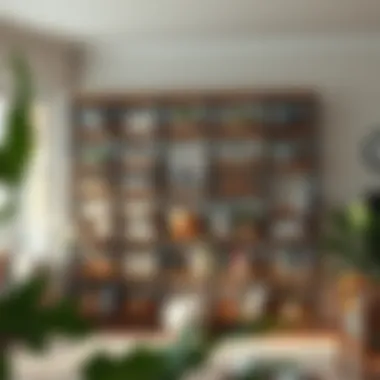
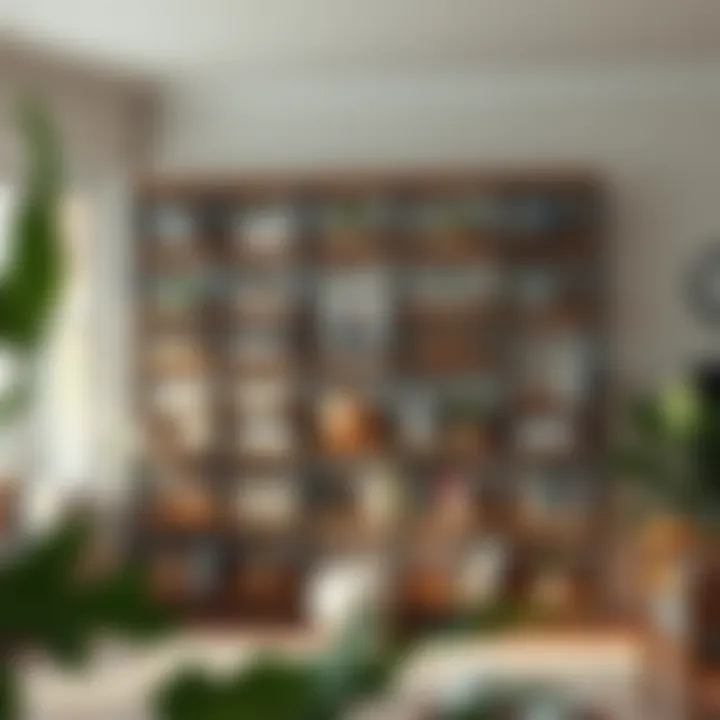
Adopting these cleaning techniques ensures your bookshelf maintains its aesthetic appeal and functionality over time.
Long-Term Preservation of Books and Decor
It’s not enough to simply maintain the bookshelf structure; you also need to care for the items sitting on it. Books and decor are susceptible to damage if not properly preserved.
- Books: Store your books upright if possible, much like soldiers standing in formation. If age starts to show, invest in acid-free boxes for better protection. Consider a dehumidifier in damp areas to prevent mold, which loves to feast on paperback pages.
- Decor items: Rotate them occasionally to prevent sun damage and fading. Positioning heavier items closer to the base of shelves is wise to maintain stability and avoid accidents.
When thinking about long-term preservation, lighting is another factor. Natural light can cause colors to fade. Position your bookshelf away from direct sunlight. For bulbs, choose LED lights because they produce less heat and are less likely to damage your treasures.
Thinking ahead can save you from costly replacements later. Take the time now for maintenance and care, and your bookshelf will continue to impress for years to come.
Practical Tips for Bookshelf Setup
Setting up bookshelves effectively is not just about storage; it's about creating a harmonious blend of style and function. In this section, we will explore practical tips that cater specifically to enhancing your bookshelf setup. These insights serve to elevate the aesthetic appeal of your space while ensuring that every shelf serves a purpose. A well-planned bookshelf can transform a plain wall into a captivating focal point, attracting the eyes and drawing attention to the treasures within.
Creating a Cohesive Look
When setting up your bookshelf, creating a cohesive look is vital. The aim here is to ensure that every element feels deliberate, giving your space an organized and appealing atmosphere.
- Choose a color palette: Begin by selecting a few key colors that resonate with your overall room design. This could be inspired by an accent color in your decor. For example, if your living room features navy blue cushions, consider arranging books with navy spines alongside other complementary tones.
- Uniform book arrangements: There��’s beauty in symmetry. Stacking books either horizontally or vertically creates visual balance. Alternate between these methods to maintain interest while adhering to your chosen color scheme. Don’t shy away from breaking the mold, though— a few well-placed books laid flat can add character.
- Incorporate similar objects: Integrate decorative elements like plants, sculptures, or framed photos that harmonize with your color palette. These accents not only enhance the look but also offer visual breaks amidst rows of books, making the bookshelf more approachable and less cluttered.
"A well-thought-out bookshelf tells a story—not just of the books it carries but of the space it occupies."
Strategic Placement Based on Usage
How you place items on your bookshelf can significantly impact both accessibility and aesthetic appeal. Let’s dive into some strategic placement tips:
- Prioritize frequently used items: Place books or items that you reach for often at eye level. This makes them easy to grab without digging through stacks. It's practical and keeps your workflow smooth, especially for home office setups where access to resources is key.
- Vary shelf depth: If your bookshelf allows for it, setting up shelves of varying depth can add a dynamic feel. Use deeper shelves for larger items and shallower ones for books or framed pieces. This creates depth and makes the visual experience engaging.
- Use lower shelves for less-used items: Items that are less often accessed can be tucked away on lower or higher shelves. This keeps the more important and frequently used pieces in plain sight, while still retaining those rarities.
- Personalization choices: Items that reflect your personality—like souvenirs from travels or unique collectibles—will add character to your space. Strategically place these items where they can draw attention but not overcrowd the books.
By thoughtfully executing these practical tips, you'll not only create a bookshelf that serves its function but also tells a cohesive story of who you are and what you value in your living space.
Inspiration from Different Cultures
Exploring bookshelf designs inspired by various cultures can be as enriching as delving into the books they hold. Different cultures across the globe have unique perspectives on space utilization, aesthetics, and functionality. These influences can breathe new life into any bookshelf, transforming it from a mere storage unit into an artistic focal point. Moreover, understanding such cultural influences not only adds diversity to one’s decor but also promotes a sense of global awareness and appreciation for craftsmanship.
As we dive into the world of bookshelves, we’ll examine two distinct approaches—Scandinavian and Japanese—each showcasing a robust philosophy that emphasizes design principles like minimalism, practicality, and the natural world.
Bookshelves in Scandinavian Design
The Scandinavian approach to design often revolves around the mantra of simplicity and functionality. Bookshelves in this style typically feature clean lines, light colors, and materials that emphasize natural beauty.
Characteristics of Scandinavian Bookshelves:
- Materials: Often made from light woods such as birch or pine, which bring warmth to spaces without feeling heavy or oppressive.
- Functionality: Many Scandinavian bookshelves are modular, allowing homeowners to adapt their storage solutions based on changing needs or room layouts.
- Minimalist Aesthetic: Clutter is given little room. Instead of cramming books into every available inch, the focus is on displaying selected items that resonate with personal taste. This often includes placing books amidst carefully chosen decor items, like potted plants or sculptures.
"Scandinavian shelves do not merely hold books; they curate experiences, reflecting a sense of calm in design."
Incorporating a Scandinavian bookshelf into your space can cultivate a tranquil environment, inviting coziness while allowing for practical organization. The overall effect is one of elegance without extravagance, making it suitable for a variety of interiors.
Japanese Minimalist Approaches
Japanese design emphasizes minimalism and the beauty of empty space, a concept known as ma. In the context of bookshelves, this manifests in designs that celebrate simplicity, elegance, and a strong connection to nature.
Key Features of Japanese Bookshelves:
- Natural Materials: The use of bamboo, paper, and unfinished wood highlights the intrinsic beauty of the materials while providing a connection to nature.
- Open Spaces: Unlike more traditional, enclosed shelving, Japanese-style bookshelves often feature open designs that embrace light and air, creating a sense of fluidity and harmony.
- Function Meets Aesthetics: Books are displayed sparingly, focusing on quality rather than quantity. Every item on display is thoughtfully chosen, illustrating not just individuality but the stories they tell.
The Japanese minimalist bookshelf can turn an ordinary room into a serene library sanctuary, where each book serves not just as literature but as an integral part of an artful arrangement.
In essence, drawing inspiration from the bookshelf designs of different cultures can spark creativity and enhance your interior decor. By understanding the principles that govern Scandinavian and Japanese designs, one can leverage these insights to create unique, functional, and culturally rich spaces.
Bookshelf Trends to Watch
Bookshelves have gone beyond mere storage spaces; they've transformed into key elements that contribute to the aesthetics and functionality of our living or working spaces. Understanding the current trends in bookshelf design not only helps in making informed choices but also encourages creating environments that resonate with one's style. These trends encapsulate innovations that skillfully marry function with design, ensuring a space that's both striking and practical.
When homeowners or interior design aficionados consider updates to their spaces, recognizing these trends can facilitate decisions that reflect personal tastes while simultaneously enhancing usability. Embracing contemporary trends often involves a deeper understanding of existing styles and innovations, which can lead to unexpected yet delightful solutions for storage challenges.
Emerging Design Styles
Today, various design styles are emerging, reflecting the evolving tastes of homeowners and the diverse functionalities of modern-day spaces. One prominent trend is the minimalist approach, which emphasizes simplicity and decluttered lines. Bookshelves designed with sleek, understated lines avoid overwhelming a room and instead, compliment its existing elements. Compact bookshelves that serve a dual purpose—such as a bookshelf that also acts as a seating area—are gaining traction as those with smaller spaces seek ways to maximize utility without sacrificing style.
Moreover, eclectic designs are making a statement. Mixing materials, like combining rustic wood with sleek metal, results in a visual feast that tells a story. Bold colors also take center stage, with people feeling liberated to opt for vibrant hues that reflect individuality. These fearless choices make a room lively and personal. A vibrant blue bookshelf against a neutral backdrop captures attention while showcasing a collection of unique items—whether books or decorative pieces.
Furniture that can change form or function is also being favored. Think about shelves that can expand or contract based on current needs, or modular bookshelves that can be reconfigured according to seasonal decor changes. Such versatility not only accommodates shifting preferences but also follows the rhythm of life, adapting seamlessly as lifestyles evolve.
Adaptive and Dynamic Shelving Units
Dynamic shelving units represent the pinnacle of innovative bookshelf design. These shelves adapt to various needs and changes in any environment. For instance, adjustable shelving heights allow for storage of varying book sizes or personal items, providing flexibility that static shelves simply cannot match.
Furthermore, systems that integrate technology are becoming increasingly common. Imagine bookshelves with built-in lighting systems that can be adjusted for ambiance or those featuring smart technology capable of syncing with personal devices to pull up digital collections. This seamless integration connects the physical storage of books with the digital world, ensuring a more holistic approach to reading and displaying personal collections.
In contemporary homes, where multifunctionality is key, dynamic shelving plays a crucial role. They serve as room dividers or contribute to creating distinct zones in open-concept spaces. Their capability to morph according to usage scenarios supports not only practicality but also encourages creativity in arranging spaces. Here, bookshelves no longer serve just a singular purpose, but rather become integral players in the choreography of interior design.
Every shelf can tell a story; it’s just about how you arrange it and what you choose to display.
Epilogue: Crafting Your Unique Bookshelf
In wrapping up our exploration of creative bookshelf ideas, it’s crucial to focus on the importance of transforming a mere shelf into a reflection of personal taste and lifestyle. Bookshelves often serve not just a functional purpose, but also as a stage upon which the drama of our lives unfolds — displaying our cherished books, beloved artifacts, and even our aspirations. Crafting a unique bookshelf is about more than just placement; it's an opportunity to narrate your story.
Reflection on Personal Style
When deciding how to curate your bookshelf, the first step is to pause and reflect on your own style. If you prefer modern aesthetics, think about using sleek, minimalist designs that emphasize clean lines and uncluttered spaces. On the other hand, if a more eclectic vibe resonates with you, consider mixing various materials and textures. Include not just books, but items that narrate your journey. This could range from travel souvenirs that remind you of distant lands, to framed photos that bring back treasured memories. Each piece should convey something personal, harmonizing function with personality.
Furthermore, the choice of color can amplify your style. A vibrant arrangement can instill energy within the room, while muted tones may invite calm. Think about what feelings you want to evoke in the space. Remember, a bookshelf doesn’t have to be boring — it can be a canvas where your unique palette of interests and personality come to life.
Encouragement to Experiment
The spirit of innovation lies in experimentation. Don’t be afraid to rearrange, repaint, or repurpose. Try different layouts with an eye toward functionality, but don’t shy away from whimsy. Use unconventional objects like vintage suitcases, reclaimed wood, or even garden pots to store books. You might just stumble upon a setup that thrilled you when first envisioned.
Also, consider seasonal changes. For instance, adorn your shelf with autumn-themed décor using warm-toned leaves and pumpkins, or switch it up for the summer with beach reads and seashells. Each alteration offers a fresh perspective, inviting rejuvenation into your space.
"An innovative bookshelf could be the key to unlocking creativity in your home. Don't just think outside the box; think about how the box can be remade altogether."
By embracing change and allowing yourself to innovate, your bookshelf becomes a dynamic part of your environment rather than a static decoration. Listen to your instincts, mix, match, and mold till the set-up resonates with your sensibilities. By doing so, you cultivate not only a bookshelf but a reflection of who you are and how you live.







